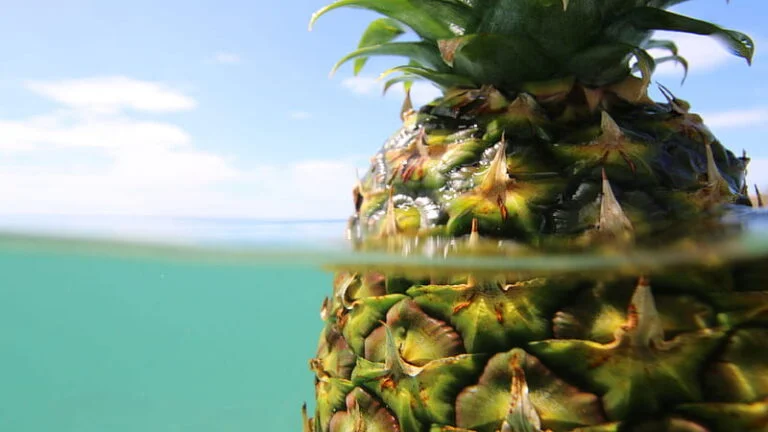Myths, Superstitions, and Maritime Lore
Throughout history, the pineapple has held a special place in maritime folklore, captivating sailors and storytellers with its mystique and symbolism. Join us as we embark on a journey to uncover the truth behind these myths and unravel the tales of pineapples at sea.
Myths of Pineapples on the High Seas
Symbol of Hospitality
Legend has it that sailors returning home from their voyages would place pineapples on their doorsteps as a symbol of hospitality. This practice was believed to signify their safe return and readiness to welcome friends, neighbors, and visitors. While heartwarming, historical evidence for this tradition is limited, and it’s likely that the symbolism of the pineapple as a hospitable gesture has evolved over time.
Precious Cargo
Step into the world of seafaring trade where pineapples transformed into prized treasures. Pineapples’ rarity and the challenges of transportation made them a sought-after delicacy, often displayed prominently on ships returning from successful journeys. This display of exotic cargo not only highlighted the crew’s achievements but also added an air of luxury and status to the ship.
Warding off Scurvy
Vitamin C, abundant in pineapples, played a crucial role in preventing scurvy [a debilitating disease that afflicted sailors on long voyages due to vitamin deficiency.] Some tales suggest that ships carrying pineapples had healthier crews with fewer instances of scurvy. While the correlation between pineapples and improved health is plausible, attributing supernatural health benefits to the fruit may be more myth than reality.
Protection from Bad Luck
The pineapple’s distinctive appearance, with its spiky crown and rough exterior, led to the belief that it possessed the power to ward off bad luck and protect ships from harm. Sailors and seafarers would often include pineapples among their cargo in hopes of ensuring safe and smooth journeys across the unpredictable seas.
Influence on Ship Design
An intriguing myth proposes that pineapples influenced ship architecture by adorning the tops of ship masts. These crowned masts were thought to bring about safe returns and foster goodwill between ships and the places they visited. While the direct influence on ship design is debated, the concept of the crowned mast adds a touch of enchantment to maritime history.

Superstitions and Sailors' Beliefs
Storm Omens
The sight of a pineapple floating in the water was considered an ominous sign by sailors—a harbinger of storms and turbulent seas. This superstition fueled apprehension among seafarers who believed that encountering a pineapple at sea could foretell imminent danger.
Sea God Wrath
A curious belief held that introducing pineapples aboard a ship could anger sea deities and bring forth misfortune. Sailors were wary of carrying this prickly fruit onboard, fearing the wrath of the gods of the deep and the calamities it might invoke.
Curse of the Pineapple
An intriguing superstition warned against consuming pineapples while at sea, as it was believed to bring bad luck to both the ship and its crew. Whether a fruit could truly harbor a curse remains a matter of conjecture, but this belief was undoubtedly an integral part of sailors’ lore.
Navigator’s Charm
Pineapples were often carried by navigators and placed strategically on ships as protective charms. Sailors believed that these charms would guide their vessels safely through treacherous waters and unknown territories.
Sea Blessing
Placing a pineapple at the helm of a ship was thought to bestow blessings upon the vessel, its crew, and its journey. This practice aimed to ensure a safe voyage and a smooth passage through the unpredictable waters.
Sailor’s Patron
For some sailors, pineapples became more than just a fruit—they were considered protective patrons of the seas. Sailors looked to pineapples for guidance and safeguarding during their maritime endeavors.
Exploring Pineapple Lore
Exotic Rarity
The allure of pineapples lay in their scarcity and exotic origins. In times when fresh produce was limited, encountering a pineapple was a rare treat that held both fascination and prestige.
Gifts of Friendship
Pineapples also facilitated cultural exchange during explorations. Sailors often exchanged these exotic fruits with indigenous communities as gestures of goodwill and friendship, forging connections between distant worlds.
Preservation Challenges
Preserving pineapples during lengthy sea voyages was a complex endeavor. Sailors experimented with various methods, from drying to pickling, in order to prevent spoilage and prolong the shelf life of this precious cargo.
Culinary Exploration
The introduction of pineapples to new regions sparked culinary exploration. These tropical delights inspired chefs and home cooks alike to experiment with new recipes and flavors, enriching local cuisines with their exotic tang.
Cultural Exchange
Pineapples became symbols of cultural exchange, reflecting the interconnectedness of diverse societies through maritime trade. The exchange of pineapples exemplified the mingling of traditions and tastes across the oceans.
Romanticized Imagery
Pineapples transcended their edible nature to become symbols of romanticized adventure and the allure of uncharted territories. Their association with the sea fueled dreams of exploration and discovery.
